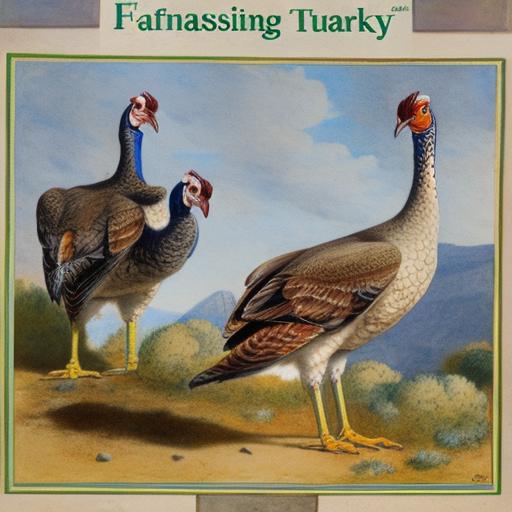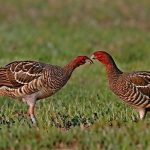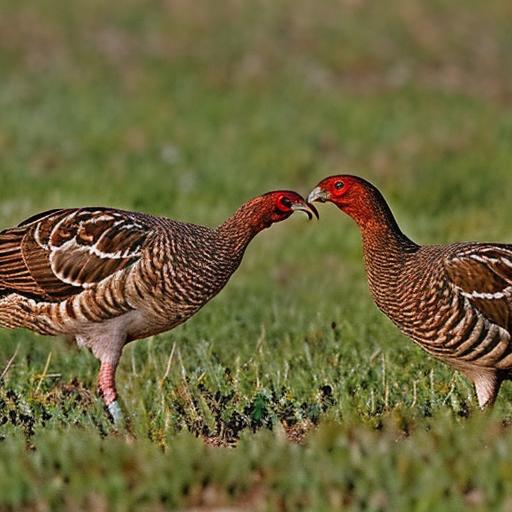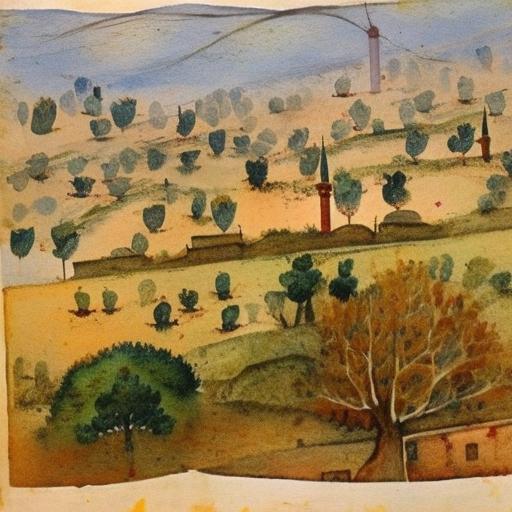Turkey breeds are a diverse group of birds that have been selectively bred for various purposes, including meat production, egg production, and exhibition. There are several different breeds of turkeys, each with its own unique characteristics and traits. These breeds can be categorized into heritage breeds, commercial breeds, rare and endangered breeds, wild turkey subspecies, and crossbred turkeys. Each breed has its own distinct history, appearance, and behavior, making them fascinating subjects for study and appreciation.
Key Takeaways
- There are several different breeds of turkeys, each with unique characteristics and traits.
- Heritage breeds of turkeys are traditional breeds that have been around for many years and are often raised for their flavorful meat.
- Commercial breeds of turkeys are bred for their fast growth and large size, making them popular choices for the meat industry.
- Rare and endangered breeds of turkeys are at risk of extinction and efforts are being made to preserve and protect these unique breeds.
- Wild turkey subspecies are the original, wild counterparts to domesticated turkeys and can be found in various regions across North America.
Heritage Breeds of Turkeys
Heritage breeds of turkeys are traditional breeds that have been raised by farmers for generations. These breeds are known for their hardiness, natural mating abilities, and ability to forage for food. Some popular heritage breeds include the Bourbon Red, Narragansett, and Standard Bronze. These breeds are prized for their rich flavor and succulent meat, making them a favorite among chefs and food enthusiasts. Heritage breeds are also valued for their ability to thrive in free-range environments, making them a popular choice for small-scale and sustainable farming operations.
In addition to their culinary appeal, heritage breeds of turkeys are also valued for their historical significance and cultural heritage. Many of these breeds have been around for centuries and have played an important role in the development of the turkey industry. By preserving and promoting heritage breeds, farmers and conservationists are helping to safeguard genetic diversity and ensure the long-term sustainability of the turkey population.
Commercial Breeds of Turkeys
Commercial breeds of turkeys are specifically bred for meat production and are the most commonly raised turkeys in the United States. These breeds are known for their rapid growth rates, large breast muscles, and high feed conversion efficiency. Some popular commercial breeds include the Broad Breasted White and Broad Breasted Bronze. These breeds have been selectively bred to meet the demands of the modern poultry industry, with a focus on maximizing meat production and efficiency.
Commercial turkey breeds are typically raised in large-scale production facilities, where they are fed a carefully formulated diet to promote rapid growth and efficient meat production. While these breeds may not have the same historical significance as heritage breeds, they play a crucial role in meeting the global demand for turkey meat. The commercial turkey industry has made significant advancements in breeding and genetics to improve the overall health and productivity of these birds, ensuring a consistent supply of high-quality turkey products for consumers.
Rare and Endangered Breeds of Turkeys
Rare and endangered breeds of turkeys are lesser-known breeds that are at risk of extinction. These breeds often have unique characteristics and traits that set them apart from more common breeds, making them valuable for genetic conservation and biodiversity. Some rare and endangered turkey breeds include the Jersey Buff, White Holland, and Slate. These breeds may have smaller populations and limited distribution, making them vulnerable to genetic erosion and loss of diversity.
Conservation efforts are underway to preserve and protect rare and endangered turkey breeds, including breeding programs, genetic preservation initiatives, and public awareness campaigns. By raising awareness about the importance of preserving these unique breeds, farmers and conservationists are working to ensure that future generations will have the opportunity to appreciate and benefit from the genetic diversity of turkey populations.
Wild Turkey Subspecies
Wild turkey subspecies are the original ancestors of domesticated turkeys and can be found in various regions across North America. These subspecies have adapted to diverse habitats and ecosystems, resulting in a wide range of physical characteristics and behaviors. Some common wild turkey subspecies include the Eastern, Osceola, Rio Grande, Merriam’s, and Gould’s. Each subspecies has its own distinct range and habitat preferences, making them a fascinating subject for wildlife enthusiasts and conservationists.
Wild turkey populations have faced significant challenges in the past, including habitat loss, overhunting, and predation. Conservation efforts have helped to restore wild turkey populations in many areas, allowing these iconic birds to thrive once again. By studying and protecting wild turkey subspecies, researchers and conservationists are gaining valuable insights into the natural history and ecology of these remarkable birds.
Crossbred Turkeys

Crossbred turkeys are the result of breeding two different turkey breeds to create offspring with specific traits or characteristics. Crossbreeding is commonly used in the poultry industry to improve traits such as growth rate, feed efficiency, and disease resistance. Some popular crossbred turkeys include the Royal Palm, Midget White, and Beltsville Small White. These hybrids may exhibit a combination of traits from both parent breeds, making them well-suited for specific production systems or market demands.
Crossbreeding can also be used to introduce genetic diversity into turkey populations, which can help improve overall health and resilience. By carefully selecting parent breeds with complementary traits, breeders can create crossbred turkeys that excel in various production environments while maintaining genetic diversity within the population.
Conclusion and Summary of Turkey Breeds
In conclusion, turkey breeds encompass a wide range of diversity, from heritage breeds with historical significance to commercial breeds bred for efficient meat production, rare and endangered breeds in need of conservation efforts, wild turkey subspecies with unique adaptations to their environments, and crossbred turkeys with a combination of desirable traits. Each breed has its own distinct characteristics and plays a valuable role in the overall genetic diversity and sustainability of the turkey population.
By understanding and appreciating the different turkey breeds, farmers, conservationists, and enthusiasts can work together to preserve genetic diversity, promote sustainable farming practices, and ensure the long-term viability of turkey populations. Whether it’s raising heritage breeds on a small-scale farm or studying wild turkey subspecies in their natural habitats, there is much to learn and appreciate about the diverse world of turkey breeds. As we continue to explore and celebrate the rich history and diversity of turkey breeds, we can contribute to the conservation and appreciation of these remarkable birds for generations to come.
If you’re curious about the diversity of poultry breeds, you might also be interested in learning about the various breeds of turkeys. Check out this fascinating article on how many eggs do geese lay to delve into the world of poultry breeding and egg production. Understanding the different breeds and their unique characteristics can be both educational and enjoyable for poultry enthusiasts.
FAQs
How many different breeds of turkeys are there?
There are approximately 6 different breeds of turkeys recognized by the American Poultry Association.
What are the different breeds of turkeys?
The different breeds of turkeys include the Broad Breasted White, Broad Breasted Bronze, Bourbon Red, Narragansett, White Holland, and Beltsville Small White.
Are there other breeds of turkeys not recognized by the American Poultry Association?
Yes, there are other breeds of turkeys that are not officially recognized by the American Poultry Association, such as the Royal Palm, Slate, and Midget White.
Do different breeds of turkeys have different characteristics?
Yes, different breeds of turkeys have distinct characteristics such as size, color, and temperament. Some breeds are known for their meat production while others are prized for their ornamental qualities.
Are all turkey breeds suitable for meat production?
While all turkey breeds can be used for meat production, some breeds, such as the Broad Breasted White and Broad Breasted Bronze, are specifically bred for their meat production and are commonly used in commercial turkey farming.
Meet Walter, the feathered-friend fanatic of Florida! Nestled in the sunshine state, Walter struts through life with his feathered companions, clucking his way to happiness. With a coop that’s fancier than a five-star hotel, he’s the Don Juan of the chicken world. When he’s not teaching his hens to do the cha-cha, you’ll find him in a heated debate with his prized rooster, Sir Clucks-a-Lot. Walter’s poultry passion is no yolk; he’s the sunny-side-up guy you never knew you needed in your flock of friends!






